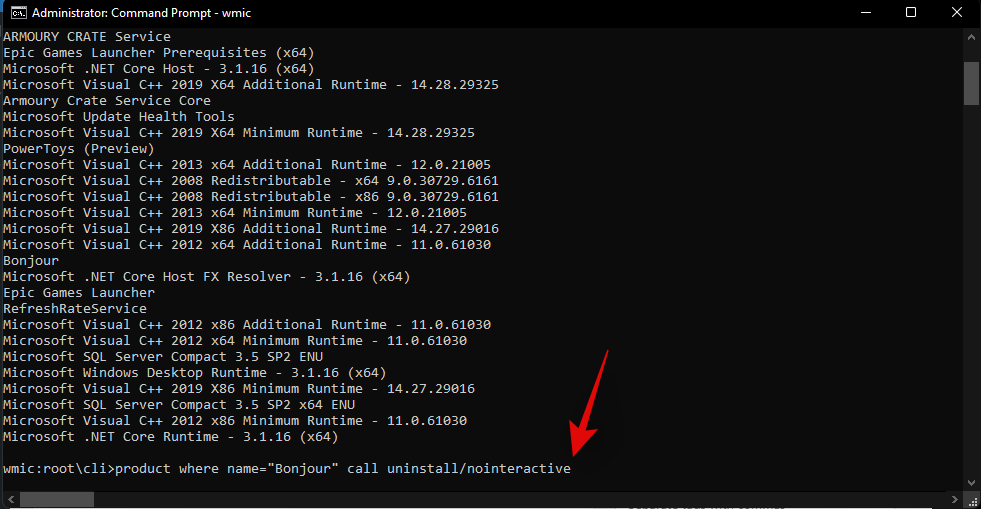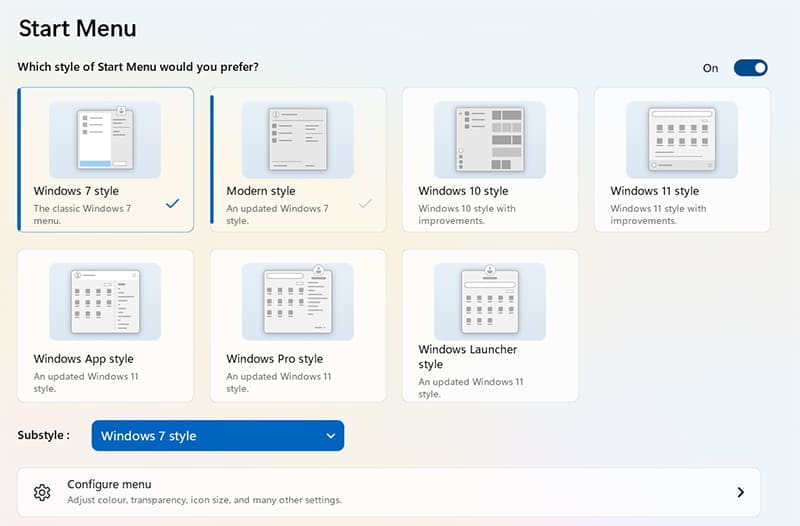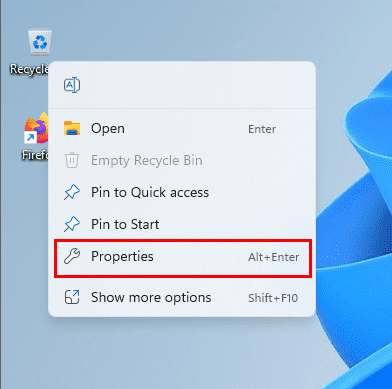Wir alle haben Zeiten, in denen wir uns wünschen, wir könnten zu einem früheren Moment zurückkehren und wieder herstellen, wie die Dinge damals waren. Obwohl es im wirklichen Leben unwahrscheinlich ist, ist dies unter Windows 11 eine einfache Realität (genau wie bei früheren Iterationen von Windows), da es uns die Möglichkeit gibt, zu dem System zurückzukehren, das zu einem früheren Zeitpunkt war.
Dazu muss man jedoch manuell einen Wiederherstellungspunkt erstellen oder zumindest Windows so konfigurieren, dass diese Punkte automatisch erstellt werden. Hier finden Sie alles, was Sie wissen müssen, um Wiederherstellungspunkte in Windows 11 zu erstellen und wofür sie gut sind.
Inhalt
So erstellen Sie manuell einen Wiederherstellungspunkt in Windows 11
Wenn Sie aus irgendeinem Grund selbst einen Wiederherstellungspunkt erstellen möchten, gibt es mehrere Möglichkeiten, dies zu tun. Werfen wir einen Blick darauf und erstellen Sie die Wiederherstellung manuell.
Methode #01: Verwenden der Systemeigenschaften
Drücken Sie Start, geben Sie „Wiederherstellungspunkt erstellen“ ein und wählen Sie die Option wie unten gezeigt aus.

Dies öffnet das Fenster Systemeigenschaften. Klicken Sie unten auf die Schaltfläche Erstellen .

Wenn dies ausgegraut ist, müssen Sie zuerst den Systemschutz aktivieren (siehe dazu den vorherigen Abschnitt).
Geben Sie diesem Wiederherstellungspunkt einen Namen und klicken Sie auf Erstellen .

Das Erstellen dieses Wiederherstellungspunkts kann einige Zeit in Anspruch nehmen, seien Sie also geduldig.
Methode #02: Verwenden der Eingabeaufforderung
Eine andere Möglichkeit, einen Wiederherstellungspunkt zu erstellen, besteht darin, dies über die Eingabeaufforderung zu tun. So geht's:
Drücken Sie Start, geben Sie cmd ein und klicken Sie auf Als Administrator ausführen .

Geben Sie nun den folgenden Befehl ein und drücken Sie die Eingabetaste:
wmic.exe /Namespace:\\root\default Path SystemRestore Call CreateRestorePoint "Restore Point Name", 100, 7

Ersetzen Sie Restore Point Nameim obigen Befehl durch das, was Sie als Wiederherstellungspunkt bezeichnen möchten. Ihr Systemwiederherstellungspunkt wird erfolgreich erstellt, wenn Sie die Meldungen 'Methodenausführung erfolgreich' und 'ReturnValue=0' erhalten.

Methode #03: Verwenden von PowerShell
Poweruser können auch mit PowerShell Wiederherstellungspunkte erstellen. So geht's:
Drücken Sie Start, geben Sie PowerShell ein und wählen Sie Als Administrator ausführen .

Geben Sie nun den folgenden Befehl ein und drücken Sie die Eingabetaste:
powershell.exe -ExecutionPolicy Bypass -NoExit -Command "Checkpoint-Computer -Description 'Restore Point Name' -RestorePointType 'MODIFY_SETTINGS'"

Ersetzen Sie Restore Point Nameim obigen Befehl durch das, was Sie als Wiederherstellungspunkt bezeichnen möchten. Sie sollten den Fortschrittsbericht Ihrer Wiederherstellungspunkterstellung sehen.

Wenn PowerShell eine Meldung (wie unten gezeigt) anzeigt, dass Sie innerhalb von 24 Stunden nicht mehr als einen Systemwiederherstellungspunkt erstellen können, müssen Sie die Registrierung dafür bearbeiten.

Sehen Sie sich die Fixes an, die später angegeben werden, um das Problem zu umgehen.
So erstellen Sie automatisch einen Wiederherstellungspunkt
Windows erstellt in einigen Fällen automatisch Wiederherstellungspunkte, aber Sie können es auch so einstellen, dass es bei jedem Neustart erstellt wird. Sehen wir uns diese beiden Themen zuerst an.
Checken Sie bereits automatisch erstellte Wiederherstellungspunkte vom System aus
Wenn die Konfigurationen der Systemwiederherstellungspunkte richtig eingestellt sind, erstellt Windows 11 automatisch Wiederherstellungspunkte, zu denen Sie zurückkehren können. So stellen Sie sicher, dass Windows die Zeitkapsel Ihres PCs für Sie übernimmt:
Drücken Sie Start, geben Sie „Wiederherstellungspunkt erstellen“ ein und wählen Sie die unten gezeigte Option.

Dies öffnet das Fenster Systemeigenschaften. Wählen Sie das Systemlaufwerk aus und klicken Sie auf Konfigurieren .

Wählen Sie nun Systemschutz aktivieren aus .

Windows weist automatisch Speicherplatz für Systemwiederherstellungspunkte selbst zu. Sie können jedoch ändern, wie viel Speicherplatz der Systemschutz verwenden darf. Bewegen Sie dazu den Schieberegler unter 'Speicherplatznutzung', um selbst Speicherplatz zuzuweisen.

Es gibt auch eine Schaltfläche Löschen , um vorherige Wiederherstellungspunkte zu entfernen. Wenn Sie fertig sind, klicken Sie auf 'Anwenden'.

Windows 11 erstellt Systemwiederherstellungspunkte, wenn größere Änderungen vorgenommen werden, z. B. wenn neue Updates angewendet werden.
So erstellen Sie beim Start automatisch einen Systemwiederherstellungspunkt
Wenn Sie nicht jedes Mal, wenn Sie eine Änderung vornehmen, die die Funktionsweise Ihres Systems beeinträchtigen könnte, die Mühe machen möchten, Systemwiederherstellungspunkte zu erstellen, können Sie die Wiederherstellungspunkte so einrichten, dass sie beim Start automatisch erstellt werden. So geht's:
Als erstes müssen Sie die Häufigkeit der Erstellung von Wiederherstellungspunkten ändern. Standardmäßig erstellt Windows keinen Wiederherstellungspunkt, wenn dieser in den letzten 24 Stunden erstellt wurde. Um dies zu ändern, führen Sie die folgenden Schritte aus:
Drücken Sie Win + R, um das RUN-Feld zu öffnen, geben Sie regedit ein und drücken Sie die Eingabetaste.

Navigieren Sie nun zu der folgenden Adresse (oder kopieren Sie sie und fügen Sie sie in die Adressleiste der Registrierung ein):
Computer\HKEY_LOCAL_MACHINE\SOFTWARE\Microsoft\Windows NT\CurrentVersion\SystemRestore

Klicken Sie mit der rechten Maustaste in den leeren Bereich rechts und wählen Sie Neu , dann DWORD (32-Bit) Wert .

Nennen Sie es SystemRestorePointCreationFrequency .

Standardmäßig ist der Wert auf 0 gesetzt. Lassen Sie es so und schließen Sie den Registrierungseditor.
Der nächste Schritt besteht nun darin, eine Aufgabe im Windows-Aufgabenplaner zu erstellen, damit bei jedem Windows-Start ein Wiederherstellungspunkt erstellt wird. Drücken Sie dazu Start, geben Sie Taskplaner ein und drücken Sie die Eingabetaste.

Klicken Sie im rechten Bereich auf Aufgabe erstellen .

Geben Sie nun auf der Registerkarte 'Allgemein' dieser Aufgabe einen Namen und wählen Sie Ausführen, ob Benutzer angemeldet ist oder nicht und Ausführen mit höchsten Berechtigungen .

Klicken Sie unten auf das Optionsfeld neben "Konfigurieren für" und wählen Sie Windows 10 aus .

Machen Sie sich keine Sorgen, wenn Windows 11 nicht zu den Optionen gehört. Da es noch keinen stabilen Build für Windows 11 gibt, wird Windows 11 möglicherweise noch nicht angezeigt. Aber seien Sie versichert, die Windows 10-Option wird weiterhin funktionieren.
Klicken Sie nun auf den Reiter „Trigger“, um dorthin zu wechseln.

Klicken Sie dann unten auf Neu .

Klicken Sie nun auf das Dropdown-Menü neben „Diese Aufgabe beginnen“ und wählen Sie Beim Start aus .
Klicken Sie dann auf OK

Klicken Sie anschließend auf die Registerkarte „Aktionen“ und wechseln Sie dorthin.

Klicken Sie unten auf Neu .

Here, we will use a few arguments to run Windows Management Instrumentation Control Program and to let it know which action needs to be taken. In the “New Action” window, ensure that the Action is to “Start a program” (default).

In the Program/script field, type wmic.exe.

Then, next to “Add arguments (optional)”, type the following command:
/Namespace:\\root\default Path SystemRestore Call CreateRestorePoint "Startup Restore Point", 100, 7

Then click OK.

Now, switch to the “Conditions tab”.

If you’re using a laptop, uncheck the option under “Power” that says Start the task only if the computer is on AC power. Then click OK.

Task Scheduler will prompt you to enter your password to complete setting up the task. Do so and click OK.

And that’s it. Now, every time you start your computer, a system restore point will be created.
How to restore Windows 11 back to a restore point
If your system runs into any trouble, you can use your restore points, whether they be created automatically or manually, to get your system back to how it was before.
There are a few ways you can restore your system. Depending on how bad a trouble your system has run into, you can use a different way to restore it.
Method #01: Using System Properties
This is the simplest way to restore your system, but it also requires you to be able to at least access the desktop and the start menu.
Press Start, type ‘Create a restore point’, and choose the option as shown below.

This will open up the System Properties window. Here, click on System Restore.

This will lead you to the System Restore window. Click Next.

Select a system restore point and click Next.

Click Finish.

Your system will now be restored.
Method #02: Using Advanced Startup
If you are not able to boot up your system, you may have to access the Advanced Startup settings and restore your system through it. There are a couple of ways you can access the Advanced Startup screen.
The first way is to turn off the device and pressing F8 before you see the Windows logo. This will boot your PC into recovery.
An alternate way is to access recovery using Windows installation media. In the Windows Setup, click Next…

and then click on Repair your computer in the bottom left corner.

Both these ways will get you to Advanced Startup.
Select Troubleshoot.

Then Advanced options.

Now click on System Restore.

Click Next.

Choose your system restore point and hit Continue.

Click Finish to have your system restored.

Can’t create a system restore point? How to fix
There can be times when, for one reason or another, you may not be able to create a system restore point. But there are a few easy fixes that you can implement to get around the issue.
Method #01: Change system restore frequency using Registry Editor
As mentioned before, by default, Windows only lets you create one system restore point if one has already been created in the last 24 hours. This can be problematic, especially if you’re looking to edit the registry or other system settings but want to ensure that there’s a restore point in case things go south. To allow the creation of system restore points at any time, you will have to change the frequency of system restore points.
Press Win + R to open the RUN box, type regedit, and hit Enter.

Now, navigate to the following address (or copy and paste it in the registry address bar):
Computer\HKEY_LOCAL_MACHINE\SOFTWARE\Microsoft\Windows NT\CurrentVersion\SystemRestore

Right-click in the empty space to the right and select New, then DWORD (32-bit) Value.

Name it SystemRestorePointCreationFrequency.

By default, its value is set to 0. Let it be that way and close the registry editor. You should now be able to create a system restore point manually without having to worry about any frequency limitations.
Method #02: Enable system restore via Group Policy Editor
Press Win + R to open the RUN box, type gpedit.msc and hit Enter.

This will open up the Group Policy Editor. In the left panel, navigate to Administrative Templated > System > System Restore.

On the right, check the state of the two Settings. They should both be set to Not configured.

If either of them is enabled, double-click on it and set it to Not configured.

You should be able to create a system restore point as shown before.
Method #03: Turn on Volume Shadow Copy service
When you’re not able to create a system restore point, another fix that you may want to implement is to turn or (or reset) the Volume Shadow Copy service. Here’s how to do so:
Press Win + R to open the RUN box, type services.msc and hit Enter.

Scroll down and look for Volume Shadow Copy. Double-click on it.

Click on Start if the service isn’t already running.

If it running, restart it by clicking on Stop…

And then on Start again.

Creating a restore point in Windows 11: FAQs
So these were all the ways that you can create a restore point and some fixes if you’re not able to create one. Now, let’s consider the most commonly asked questions about system restore points and why it’s crucial that you create them from time to time, or at least have your system set up to create them automatically.
Are restore points created automatically on Windows 11?
Yes, Windows 11 by default has its System Properties set to create system restore points automatically from time to time, such as when you apply an update or make important changes to your system.
Why should you manually create a restore point?
As mentioned earlier, by default, Windows 11 will create restore points for your system to revert to should it run into a problem. But there can be instances when, for one reason or another, Windows might not be able to do so itself.
Although there are fixes that can resolve this issue (mentioned earlier), you should look to manually create a system restore point in case they don’t work out. It is even more crucial that you do so if you’re messing around with the registry or making other drastic changes to your system. You never know when they might come in to save your system from becoming unusable.
What happens when you create a restore point?
When a system restore point is created, Windows takes a snapshot of your system data as it is at a particular time. The state of the operating system is thus saved so that you can revert back to it in case things go wrong.
How long does it take to create a restore point?
Je nachdem, wie viele Daten gespeichert werden müssen, kann das Erstellen eines Wiederherstellungspunkts zwischen wenigen Minuten und mehreren Stunden dauern. Wenn Sie jedoch nach vier bis fünf Stunden feststellen, dass immer noch ein Wiederherstellungspunkt erstellt wird, sind wahrscheinlich Probleme mit Windows aufgetreten. In einem solchen Szenario möchten Sie möglicherweise den gesamten Vorgang abbrechen und erneut beginnen.
Wir hoffen, dass Sie mit Hilfe dieser Anleitung Systemwiederherstellungspunkte erstellen konnten.































































![So deinstallieren Sie McAfee unter Windows 11 [5 Möglichkeiten] So deinstallieren Sie McAfee unter Windows 11 [5 Möglichkeiten]](https://cloudo3.com/resources8/images31/image-4917-0105182719945.png)









![Wohin gehen Windows 11-Screenshots? [auch Windows 10] Wohin gehen Windows 11-Screenshots? [auch Windows 10]](https://cloudo3.com/resources8/images31/image-8514-0105182738918.png)












